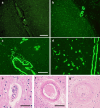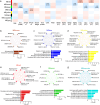Impact of APOE on cerebrovascular lipid profile in Alzheimer's disease
- PMID: 41060400
- PMCID: PMC12507989
- DOI: 10.1007/s00401-025-02949-5
Impact of APOE on cerebrovascular lipid profile in Alzheimer's disease
Abstract
Disturbances within the cerebrovascular system substantially contribute to the pathogenesis of age-related cognitive impairment and Alzheimer's disease (AD). Cerebral amyloid angiopathy (CAA) is characterized by the deposition of amyloid-β (Aβ) in the leptomeningeal and cortical arteries and is highly prevalent in AD, affecting over 90% of cases. While the ε4 allele of apolipoprotein E (APOE) represents the strongest genetic risk factor for AD, it is also associated with cerebrovascular dysregulations. APOE plays a crucial role in brain lipid transport, particularly in the trafficking of cholesterol and phospholipids. Lipid metabolism is increasingly recognized as a critical factor in AD pathogenesis. However, the precise mechanism by which APOE influences cerebrovascular lipid signatures in AD brains remains unclear. In this study, we conducted non-targeted lipidomics on cerebral vessels isolated from the middle temporal cortex of 89 postmortem human AD brains, representing varying degrees of CAA and different APOE genotypes: APOE ε2/ε3 (N = 9), APOE ε2/ε4 (N = 14), APOE ε3/ε3 (N = 21), APOE ε3/ε4 (N = 23), and APOE ε4/ε4 (N = 22). Lipidomics detected 10 major lipid classes with phosphatidylcholine (PC) and phosphatidylethanolamine (PE) being the most abundant lipid species. While we observed a positive association between age and total acyl-carnitine (CAR) levels (p = 0.0008), the levels of specific CAR subclasses were influenced by the APOE ε4 allele. Notably, APOE ε4 was associated with increased PE (p = 0.049) and decreased sphingomyelin (SM) levels (p = 0.028) in the cerebrovasculature. Furthermore, cerebrovascular Aβ40 and Aβ42 levels showed associations with sphingolipid levels including SM (p = 0.0079) and ceramide (CER) (p = 0.024). Weighted correlation network analysis revealed correlations between total tau and phosphorylated tau and lipid clusters enriched for PE plasmalogen and lysoglycerophospholipids. Taken together, our results suggest that cerebrovascular lipidomic profiles offer novel insights into the pathogenic mechanisms of AD, with specific lipid alterations potentially serving as biomarkers or therapeutic targets for AD.
Keywords: Alzheimer’s disease; Amyloid β; Apolipoprotein E; Cerebral amyloid angiopathy; Human induced pluripotent stem cell; Lipidomics; Tau; Vascular mural cells.
© 2025. The Author(s).
Conflict of interest statement
Declarations. Conflict of interest: The authors declare no competing interests.
Figures





References
-
- Ali H, Kobayashi M, Morito K, Hasi RY, Aihara M, Hayashi J et al (2023) Peroxisomes attenuate cytotoxicity of very long-chain fatty acids. Biochim Biophys Acta Mol Cell Biol Lipids 1868:159259. 10.1016/j.bbalip.2022.159259 - PubMed
-
- Antonny B, Vanni S, Shindou H, Ferreira T (2015) From zero to six double bonds: phospholipid unsaturation and organelle function. Trends Cell Biol 25:427–436. 10.1016/j.tcb.2015.03.004 - PubMed
-
- Barelli H, Antonny B (2016) Lipid unsaturation and organelle dynamics. Curr Opin Cell Biol 41:25–32. 10.1016/j.ceb.2016.03.012 - PubMed
MeSH terms
Substances
Grants and funding
LinkOut - more resources
Full Text Sources
Medical
Miscellaneous

